The Nexus 7 (2013) Review
by Anand Lal Shimpi on August 22, 2013 6:00 PM ESTCPU Performance
The while the original Nexus 7 was fast for the money, the new Nexus 7 is just fast. Moving away from NVIDIA to Qualcomm, ASUS and Google settled on the APQ8064 Pro. Although we originally assumed this would be a quad-core Krait 200 based SoC, Brian's teardown revealed the part number 8064-1AA. What's special about that part number is it implies newer Krait 300 cores, making the SoC effectively a Snapdragon 600.
The CPU cores can run at up to 1.5GHz, putting it a bit lower than what we've seen from Snapdragon 600 based phones (e.g. HTC One tops out at 1.7GHz, while the US SGS4 hits 1.9GHz).
I was curious as to the impact of the lower frequency when combined with the potentially higher chassis TDP so I compared the Nexus 7 to the US Galaxy S 4. I turned to Geekbench because it offers a nicely woven mixture of single and multithreaded benchmarks, letting me look at peak available single core performance as well as what happens when multiple cores are active and working.
In this first graph we're looking at the first Krait 300 core running the workload. I've zoomed in to a small portion of the benchmark so we can get a better idea of CPU behavior:
The Nexus 7's CPU0 is almost always pegged at 1.5GHz whereas we see a lot of bursty thermal management on the smaller SGS4. This isn't unexpected, but what ends up happening is the sustained performance advantage drops from a peak theoretical max of 26% down to a more reasonable average gain of ~8%.
I was curious to see if multithreaded workloads showed any different behavior. Here we're looking at the fourth CPU core (CPU3). Note that it's not always active, which is why you see parts of the graph drop down to 0KHz. Once again we see similarly static behavior from the Nexus 7. Even with all four cores active, when you need the performance the Nexus 7 delivers a full 1.5GHz. These tests are short enough where we don't see tremendous swings in frequency, but once again we do see some frequency modulation in a smaller chassis.
The end result is that the Nexus 7's 1.5GHz Krait 300 cores are slower than what you'd get in a Galaxy S 4, however the gap isn't nearly as large as you'd expect it to be thanks to the larger chassis and how the platform is tuned. The Nexus 7 can run at 1.5GHz more consistently than Snapdragon 600 based phones can run at 1.7/1.9GHz.
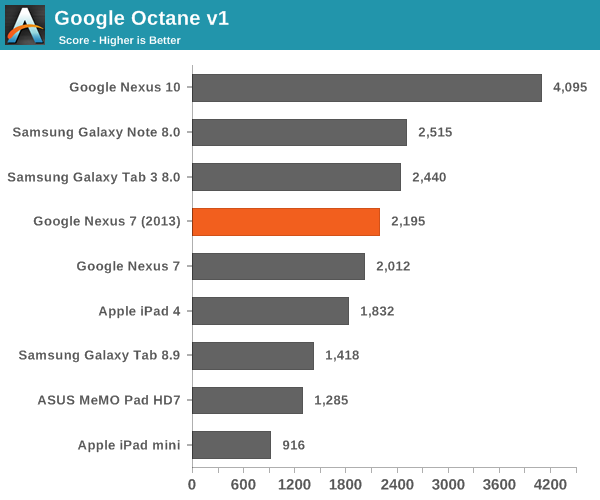


The GPU
Qualcomm seems to be frequency binning here, which is standard industry practice. Using binning to create these different SKUs gives Qualcomm pricing flexibility and also gives it the option to give large customers special treatment.
On the graphics side Qualcomm's Adreno 320 GPU makes an appearance. Clock speeds are also limited to 400MHz, compared to 450MHz for the high-end Snapdragon 600 implementations we've seen.
The APQ8064-1AA's dual-channel memory controller is populated with four x 16-bit DDR3L-1600 memory devices, giving the Nexus 7 a healthy amount of memory bandwidth. Peak memory bandwidth available to the APQ8064-1AA is 12.8GB/s, equalling what's available to Apple's A5X in the 3rd generation iPad with Retina display. Tons of memory bandwidth is obviously a pre-requisite for driving a high resolution display, and the combination of DDR3L-1600 and the Adreno 320 GPU delivers a butter smooth UI in all well written Android apps.
Although CPU performance is somewhat middle of the road compared to the rest of the landscape, GPU performance is faster than any other Nexus device on the market - and pretty much faster than any other similarly sized tablet:
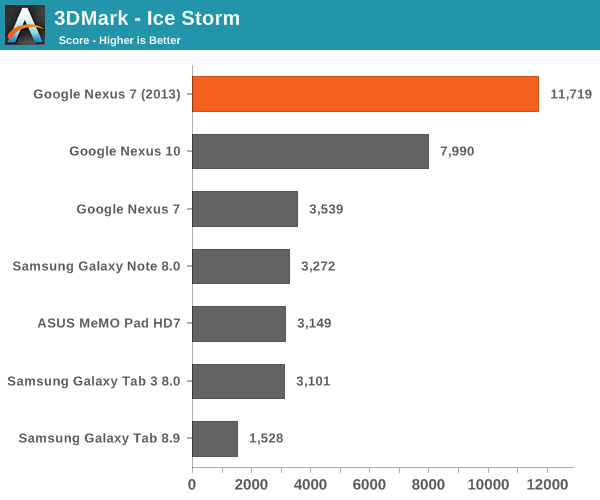
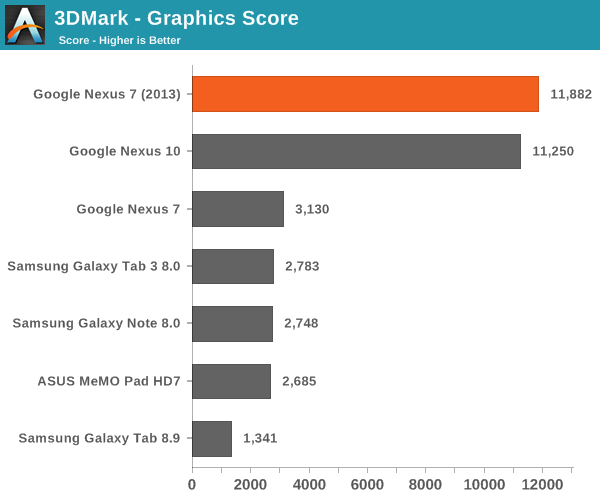
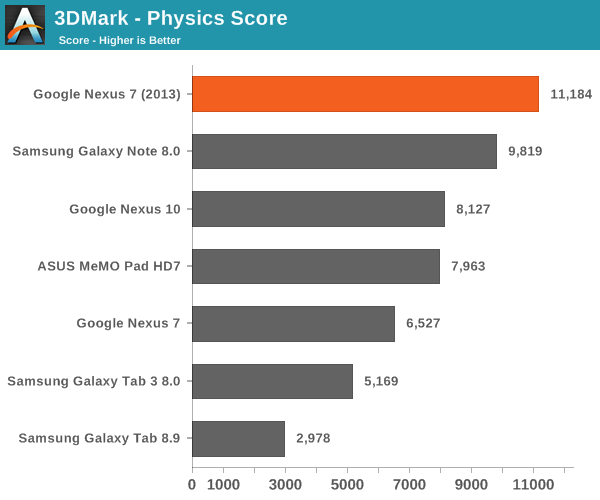
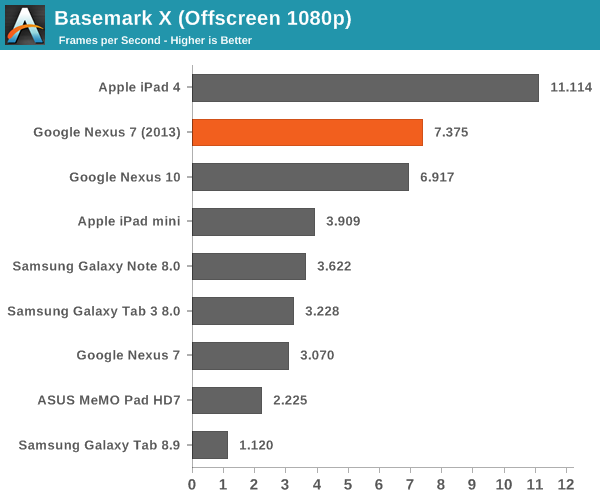
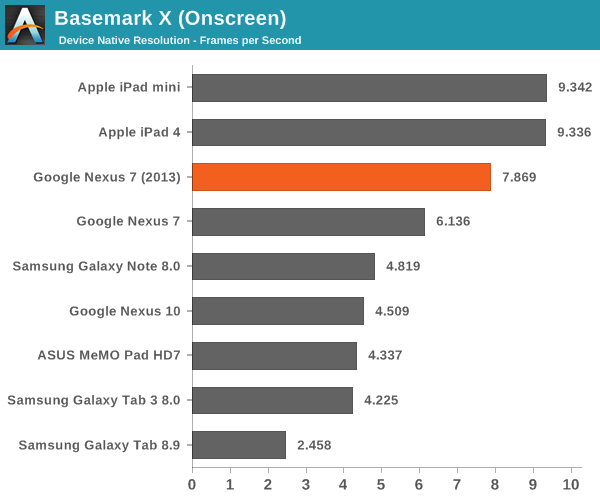
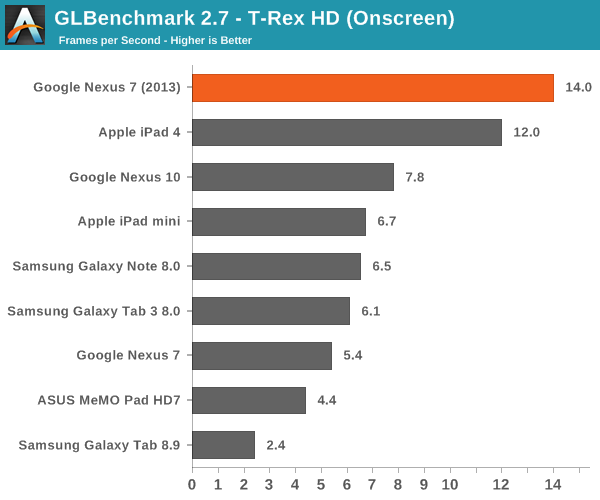
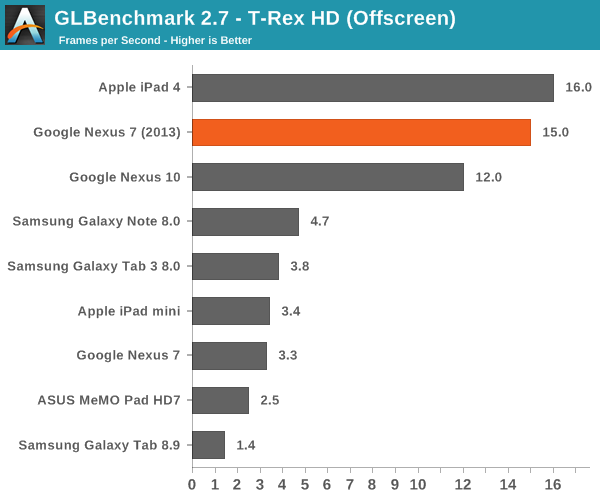
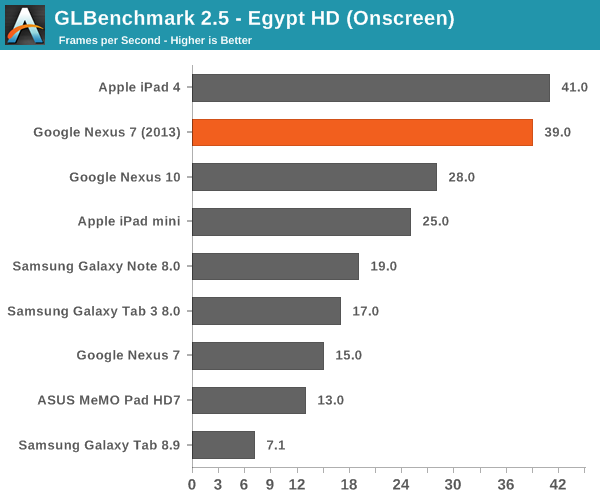
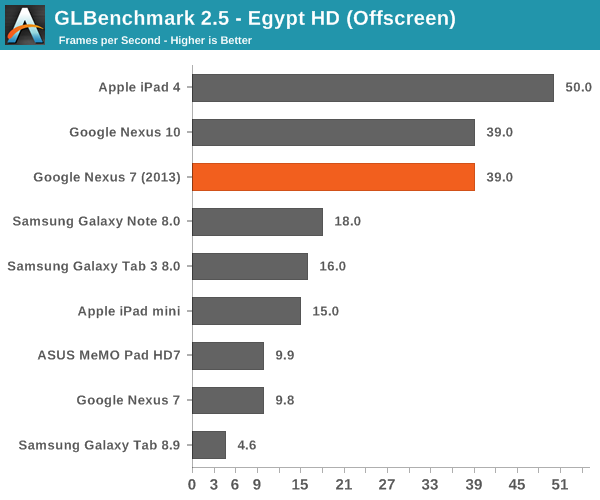
I played Modern Combat 4 as well as Shadowgun, both demanding 3D titles, on the new Nexus 7. Both titles appeared to render at the Nexus 7's native 1920 x 1200 resolution, and both appeared to do so at around 30 fps.


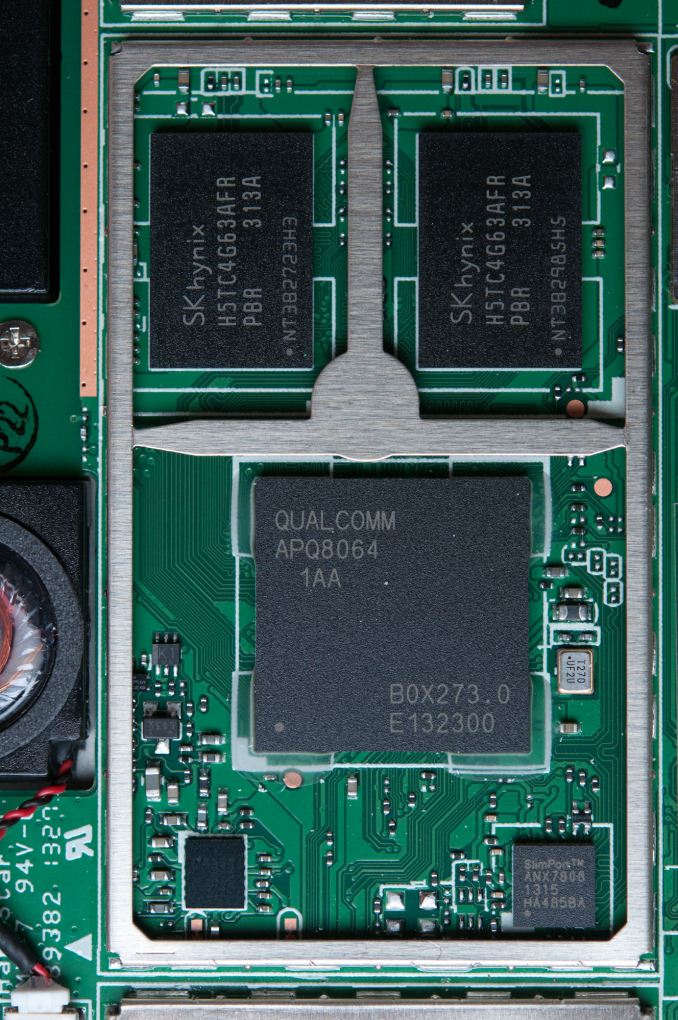
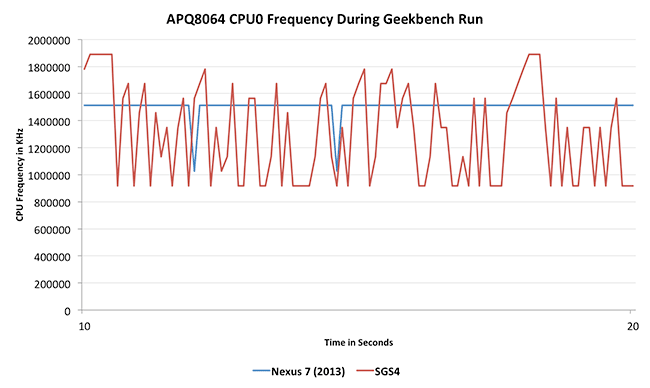
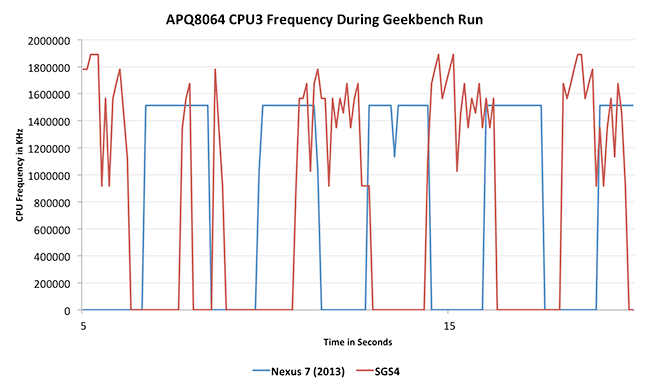








202 Comments
View All Comments
doobydoo - Sunday, August 25, 2013 - link
Retina is an Apple marketing term but the science behind it is not Apple's to change.Put simply, a retina device is a device which, when used at a normal viewing distance (11 inches for smartphones, for example) does not have discernible pixels for people with 20/20 vision.
That's the definition, period.
Whether it's useful to you or not depends on whether you have 20/20 vision, or perhaps whether you hold your device closer or not.
The iPad 4 is retina because it would typically be held further away from your eyes than a smartphone, whereas the Nexus 7 with its significantly smaller screen would be held closer (but also still qualifies as retina).
For perfect vision, the absolute best you can find in anyone, ever, at 12 inches you'd be looking at a possible perception of 700 PPI.
Fri13 - Thursday, November 14, 2013 - link
Now after a longer time when both has been released, a Nexus 7 (the 2013 model) and iPad Mini (with Retina display) there is no actual difference.Nexus 7 has 323 PPI while iPad Mini has 326 PPI so the difference is only a 3 pixels what is nothing even if other would have only 150 PPI. As that is small enough to offer a sharp text and pictures and in this case both are over 320 PPI what is over twice needed to offer sharp text and pictures. The first gen iPad mini was 163 PPI what was enough, but for many it isn't "enough" because they want specs to be updated no matter if there are no reasons to do so.
And you don't want to compare operating systems, it is useless as you don't want to compare filesystems, process schedulers, filesystem schedulers, memory management efficiency, network protocols stacks like TCP/IP or process threading etc etc. You want to compare only the graphical user interfaces like what user see, how they are designed (logic) and what functions does device offer for developers so users can post-install wanted software from different sources than just manufacturer own (so you can be in control of your device) and most important thing, how well does the devices work in ecosystem (== how well can all devices share data between each other no matter who is manufacturer or what software is used. Every device belongs to one and the same "ecosystem").
darwinosx - Thursday, August 22, 2013 - link
Android tablet apps are not close to iOS tablet apps in selection and quality. Anyone who owns a Nexus 10 knows this if they are truthful.There will be a new iPad Mini in a few weeks and Apple will settle all family business. The old iPad Mini sold dramatically better than the old Nexus 7 and this will be no different.
What you and Anand don't mention is that Nexus devices are sold at cost.
As I said earlier I have bought three of these as gifts in the last month or so. But the screen is too small for me and app quality and election is lacking. A retina iPad Mini is going to blow the doors off the Nexus 7 in sales. Watch.
smartypnt4 - Thursday, August 22, 2013 - link
Well, no one ever argued that...The iPad mini will sell more, regardless of how the specs compare. That's simply because there's a lot of people in this world that want something they already know how to use, and iOS is what the learned at the beginning of the smartphone race.
Now, that app selection thing: the advantage of the 7" form factor is that the apps built for phones aren't completely useless on this screen. After owning a N10 and now a 2013 N7 (with an iPad in between, mind you), I can say that the situation on the N10 was terrible. So many apps just didn't come close to being usable. The other bit is, I really don't use that many apps any more, so there may be some people in that camp. I can't say for sure due to my relatively small sample size (me and a few friends who care).
All in all, Apple has no excuse if they don't show up with a retina-fied iPad mini this fall. Last year, it was argued that the mini doesn't have an awesome screen due to cost, availability, and the power drain it'd suffer. The 2013 N7 shows that it's completely possible to do in today's world, regardless of what was possible last year. I really do hope Apple shows up with a good competitor specs-wise, because I'd hate to not have a choice as far as small tablets are concerned. We hardly have a choice on the large tablet side as it is.
mmarafie - Friday, August 23, 2013 - link
AgreedWarpGuN - Friday, August 23, 2013 - link
crap apple will never compete spec-wise with Nexus they will always be behind. Overpriced crap designed for the non-geek, Android is dominating with smartphones and tablets Apple is losing market shares everydayakdj - Friday, August 23, 2013 - link
WarpGun....what? Are you six years old? That's your offering to the discussion? Good grief....grow up a bit, then come back and join us for a real discussion. The two companies go back and forth every year beating each other in 'specs'. Just take a look at last years gear vs this years. Ridiculous comment, as the iPad (both mini and regular) are at the end of their cycle. And with this in mind, the iPad 4 still fairs pretty well against current competition even being a year old.The article hasn't anything to do with market share...but Apple has never 'lost' market share. Each iteration if iOS device has outsold the last. In fact, this past quarter the iPhone outsold YoY itself by an extra 5mil units. Get out of your basement, get a job, and try to contribute to the discussion at hand rather than spread your personal agenda
The new nexus 7 is one helluva tablet. An excellent review from a legitimate reviewer to boot. Isn't that enough to make you 'happy' to be an Android fan?
Miggleness - Friday, August 23, 2013 - link
This is the first time I paid attention to the size difference between the Nexus and iPad Mini. That's another big factor in my next purchase and the Nexus just feels too small.Thanks for the review Anand. This is the reason I keep coming back to your site.... twice daily!
ESC2000 - Sunday, August 25, 2013 - link
Actually the nexus displays more on its screen than the mini because of how many more pixels the nexus has even though the mini's screen real estate is about a third bigger. I've messed with the two next to each other and the nexus looks way better. Of course the nexus is much newer. Still I expect the new mini to be either overpriced or underspecced... or both like the first mini.doobydoo - Monday, August 26, 2013 - link
Actually, no it doesn't, because despite the increase in resolution, the Nexus doesn't shrink everything compared to its predecessor. It still displays less than the iPad Mini, because if it didn't everything would be too small.I also now don't believe that you've compared the two side by side because if you had, you would know this.